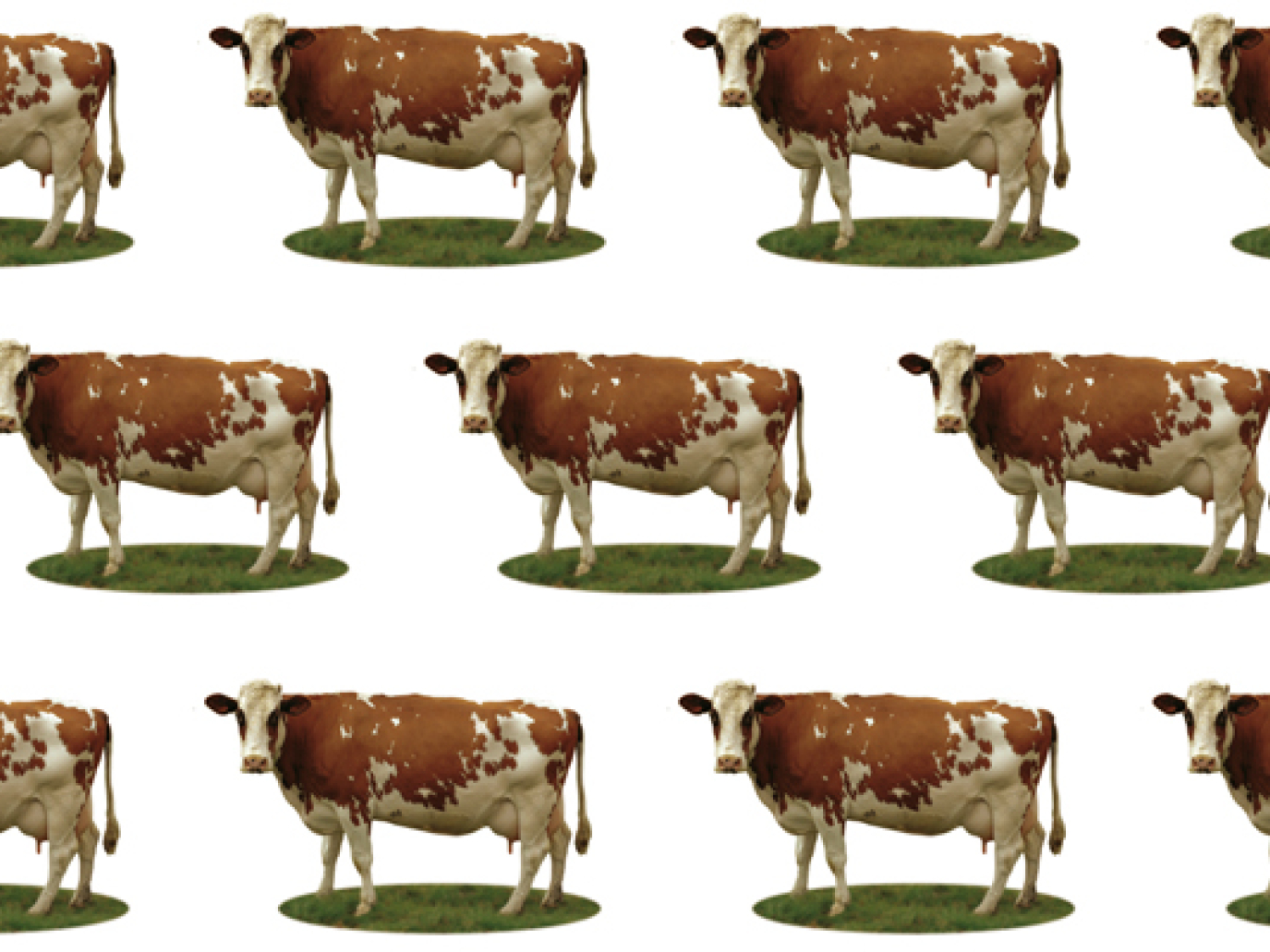According to estimates by Water Footprint Network, for each ton of vegetables an average 300 cubic metres of water (300,000 litres) are needed; 1,000 for fruit; 1,600 for cereals; 4,000 for pulses. It is even worse for derivatives: 1,000 litres of bioethanol made from corn need 2.9 million litres of water; a ton of butter needs 5.5 million litres; a ton of beef steaks needs 15.5 million litres. Then there is war for land, or land grabbing, which according to Oxfam has doubled since 2008. According to FAO, at least 55% of all arable land is used for agriculture and livestock.
In this context of global scarcity of biomass and its factors of production, it is necessary to answer the question posed in the above mentioned article: are agricultural residues and the enormous quantity of waste produced in our economy sufficient to feed the bioeconomy and avoid that the new demand for biomass exacerbate conflicts? Here we will try and provide not the answer itself – which would require an analysis of the economic trends and the technological prospects beyond the reach of this article – but rather some quantitative elements necessary to answer that question.
At global level, according to data by www.materialflows.net, human beings “manage” about 27 billion tons a year of primary, cultivated or natural biomass. We are talking about 22% of global mineral extraction and – according to estimates by Haberl et al. for the year 2000 – about a quarter of all products that photosynthesis generates on earth.
This data gives us an idea of the total flux that we need to focus on and which comprises food, biomaterials (traditional and new) and biofuels. In the short term, expanding this total figure is possible only by intensifying or extending agricultural activities, two prospects that give rise to many problems and end up colliding with several of the planetary boundaries already known to this journal’s readers. Agricultural and forestry activities, through which human beings appropriate biomass, as well as the ways in which they stimulate its growth, generate huge pressure on areas where the planetary boundaries have already been surpassed, such as loss of biodiversity, interference with natural nitrogen and phosphorus cycles, and climate change.
The most interesting prospect, one where bioeconomy and sustainability can go hand in hand, is the “multiple” use of biomass. The majority of residues generated by extraction, transformation and final use of primary biomass are suitable for successive uses and transformations. These reuses do not increase the general figure, however they lengthen the economic life of matter, postponing the moment when materials go back to nature, or optimizing the way they do that.
Behind the 27 billion tons figure there is a complex scenario. 20% of these biomasses (5.5 billion tons, 0.7 in Europe) constitute a non tradable sub-product coming mainly from cultivation of products fit for human food (over 80%). Other cultivations and forestry activities generate, per unit of main product, a significantly inferior quantity of residues. These residues however are far from useless, even though they are not tradable. If left in the soil, they give back to the land what had been taken, and they are useful to produce new biomass. The same happens if organic matter is given back to the soil after composting. These ways of disposal, which allow for a limited use of artificial fertilizers and add value (although implicitly) to waste, are definitely part of the bioeconomy. Where burnbeating (burning on site) is carried out – a process which in the long term impoverishes the soil depriving it of organic mass – or where the biomass is gathered without being somehow recovered, the bioeconomy can certainly play an important role, both in terms of sharing best practices of soil restitution, and in other more explicit ways of valuing waste, such as the production of new materials and fuel. Unfortunately, there aren’t statistics available on the incidence of the various modes of disposal of agricultural waste at the global level, nor is it possible to formulate reliable estimates.
Of the 22 billion tons used – 2.7 billion in Europe – eight are suitable for human feeding, 11 are used to feed animals; 2.5 billion tons of wood and products are taken from forests – either virgin or not. Only a part of the latter flow is acquired by humans through using the extremely precious stocks of natural biomass (demolition of virgin forests and excessive fishing). The remaining part comes almost exclusively from new biomass that is generated annually.
Together with the burning of stubble, wood burning releases a million tons of carbon into the atmosphere. As far as the eight billion tons of food suitable for human beings, we need to take into account the “costs” (in terms of matter subtraction) of transformation and food waste. According to FAO, only the latter transforms at least a third of biomass suitable for human feeding into residues. Taking into account also what is left from transformation and consumption – even though it is not considered waste (non-edible food parts) – we can estimate that about four billion tons of biomass could be further reused as waste, after industrial transformation and/or consumption. In this case, the bioeconomy can prove useful in recovering this precious matter and using it to increase soil fertility, generate industrial processes and energy networks.
The remaining eight billion tons suitable for human feeding, once ingested and digested, follow the same path as the 11 billion tons destined for animals; they partly become emissions released into the atmosphere (part of the carbon and hydrogen contained in food is merged with breathed oxygen by animal metabolism and transformed into methane by enteric fermentation), and partly excrements. It would be useful to have available estimates expressed in terms of dry matter or with standardized humidity, while only the fodder (most of the 11 billion tons destined for animals) is quantified by normalizing its water content to 15%. As for the dry ingested matter, the carbon contained in emissions can be estimated at around one billion tons and at least four fifths of it comes back as excrements. We are talking about at least eight billion tons of dry matter. Again, this can be sent back to the soil and/or used to produce biogas.
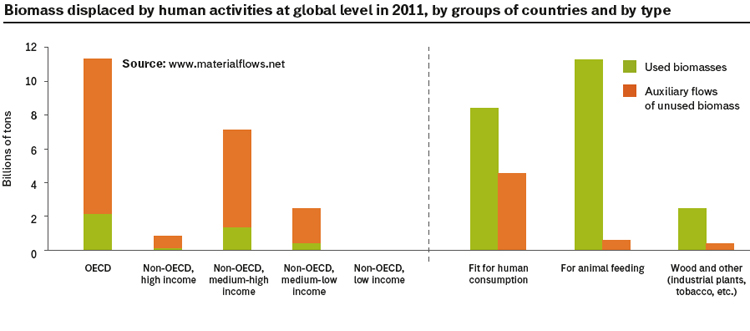
The Italian Context
Italy – with its annual water footprint of 130,000 million cubic metres, 61% of which is outside its borders; with its ecological footprint equivalent to 3.8 times its biocapacity, and several companies buying land overseas (often to produce biofuels) – shares with most of the rich world a strong incentive to properly manage the biomass at its disposal.
Like most European countries, Italy is a net importer of natural materials. For renewable resources, unlike non-renewable ones, there is a potential trade-off between internal extraction and imports: in 2013 biomass constituted 27.8% of internal extraction of used materials and 13.4% of flows from abroad. The latter covered about 27% of the need for biomass in the productive system and among consumers in the country.
Flows from abroad have been increasing, while internal extraction has been constantly decreasing for at least twenty years: the substitution effect is evident.
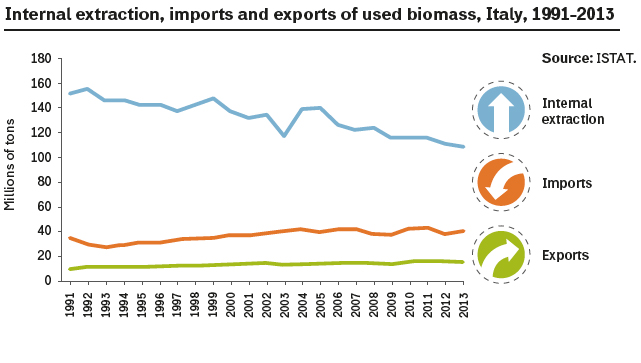
Internal extraction tends to diminish for all types of used biomass: those destined to zootecnics in 2013 amounted to 46.5 Mt, those that could be destined for human feeding amounted to 56.5 Mt, resources taken from forests amounted to 5.5 Mt. To internal extraction we need to add imported biomass: these are agricultural products that could potentially be used by agribusiness and its products. Biomass produced and processed in Italy is then increasingly exported: 40 Mt in 2013. The role that Italy has been acquiring is evident: a transformer of biomass, less and less a primary producer. This brings with it a reduction in agricultural residues, an important element for the energy industry. It would be interesting to follow the several supply chains of biomass, to observe the residues as soon as they emerge and analyze the way in which they are used or wasted. While we leave this exercise for a later date, here we try and formulate a general framework and follow some quantitatively and qualitatively important flows, among them those that take matter from plants back to the soil.
Putting together data by ISTAT and ISPRA, it is possible to define, albeit with many approximations, a general picture of transformation of biomass used in our country, counting both fodder and manure as dry matter.
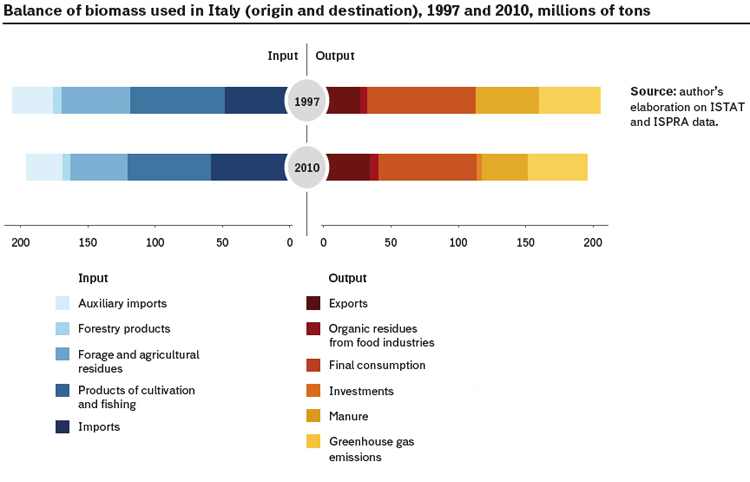
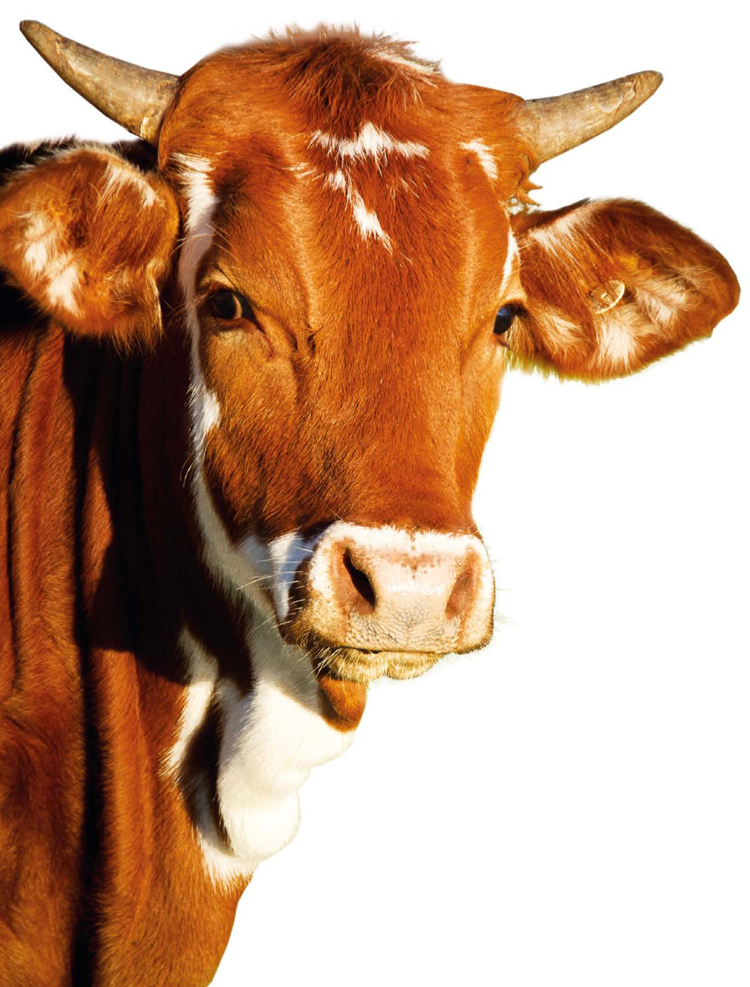 By comparing 1997 and 2010 it appears clear that, in addition to an increase in total flows of external trade (imports from 24 to 31%, exports from 13 to 18%), zootecnics is having a more marginal role. However, the dry matter contained in manure – a precious fertilizer – produced in Italy, still amounts to at least 30 million tons. The residues from agriculture and forestry produced in Italy, according to very careful estimates that do not take into account many cultivations and are expressed in terms of dry matter and obtained from information published by ISPRA, amount to about 18 million tons. A third of these materials are already used in several ways. According to a more complete yet less accurate estimate, available on www.materialflows.net, expressed in tel quel weight, the production of agricultural residues amount to 76 million tons. ISPRA is also telling us that separate collection of wet fraction in 2012, equivalent to 4.8 million tons, represented 40% of recycling in Italy (with a ratio of 13:1 between per capita gathered quantities in the most virtuous region – Emilia Romagna – and the last on the list – Calabria). Of these residues, the green part which is collected separately – 1.8 tons – is already part of the estimates of the agricultural residues mentioned above. On the other hand, the remaining 5 Mt (wet fraction of urban solid waste) mainly come from final consumption by families and service companies. In 2011, 3.5 Mt of organic waste were treated. Another 0.5 Mt were used in anaerobic digestion. According to a study by SDA Bocconi, the amount of collected material could almost double, by extending separate collection of wet fraction to all Italian municipalities (in 2014 it was done by 4,200 municipalities). This would also eliminate 7.7 Mt of CO2 emissions, and would generate a thousand jobs and 12 million euros in added production. What the business school researchers conclude is that the organic supply chain shows that circular economy can work. And if they say so...
By comparing 1997 and 2010 it appears clear that, in addition to an increase in total flows of external trade (imports from 24 to 31%, exports from 13 to 18%), zootecnics is having a more marginal role. However, the dry matter contained in manure – a precious fertilizer – produced in Italy, still amounts to at least 30 million tons. The residues from agriculture and forestry produced in Italy, according to very careful estimates that do not take into account many cultivations and are expressed in terms of dry matter and obtained from information published by ISPRA, amount to about 18 million tons. A third of these materials are already used in several ways. According to a more complete yet less accurate estimate, available on www.materialflows.net, expressed in tel quel weight, the production of agricultural residues amount to 76 million tons. ISPRA is also telling us that separate collection of wet fraction in 2012, equivalent to 4.8 million tons, represented 40% of recycling in Italy (with a ratio of 13:1 between per capita gathered quantities in the most virtuous region – Emilia Romagna – and the last on the list – Calabria). Of these residues, the green part which is collected separately – 1.8 tons – is already part of the estimates of the agricultural residues mentioned above. On the other hand, the remaining 5 Mt (wet fraction of urban solid waste) mainly come from final consumption by families and service companies. In 2011, 3.5 Mt of organic waste were treated. Another 0.5 Mt were used in anaerobic digestion. According to a study by SDA Bocconi, the amount of collected material could almost double, by extending separate collection of wet fraction to all Italian municipalities (in 2014 it was done by 4,200 municipalities). This would also eliminate 7.7 Mt of CO2 emissions, and would generate a thousand jobs and 12 million euros in added production. What the business school researchers conclude is that the organic supply chain shows that circular economy can work. And if they say so...
Bibliography
- H. Haberl et al., 2007, “Quantifying and mapping the human appropriation of net primary production in earth’s terrestrial ecosystems”, Proceedings of the National Academy of Sciences, v. 104, n. 31, 12,942-12,947; doi: 10.1073/pnas.0704243104
- ISPRA, Rapporto rifiuti urbani 2013; www.isprambiente.gov.it/it/pubblicazioni/rapporti/rapporto-rifiuti-urbani-edizione-2013
- ISTAT, Sommario delle Statistiche Storiche; seriestoriche.istat.it
- R. Martino, A. Montermini, “Quando si possono bruciare i residui colturali in campo”, www.fitosanitario.re.it/files/2913/9704/9885/Articolo_39_2013.pdf
- M. M. Mekonnen, A. Y. Hoekstra, 2011, “The green, blue and grey water footprint of crops and derived crop products”, Hydrol. Earth Syst. Sci., 15(5): 1577-1600; doi:10.5194/hess-15-1577-2011
- SDA Bocconi, Analisi della filiera del compostaggio, June 2014; www.slideshare.net/MilanoRecycleCity/analisi-della-filiera-del-compostaggio
- P.M. Vitousek et al., 1986, “Human appropriation of the products of photosynthesis”, BioScience, v. 36, n. 6, p. 368-373


